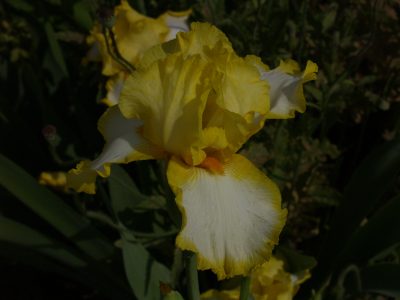When and how do I fertilize irises?
Iris flowers are so pretty that if you’ve ever had a year with no blooms, and most of us have, you want to do whatever you can to ensure a good spring show.
Fertilizing definitely plays a key role in blooming. Note, though: over-fertilization can just as easily cause problems as not fertilizing at all. As with most plants, too much nitrogen leads irises to concentrate more on green growth at the expense of flowering, and sometimes to even avoid blooming altogether.
With irises and other flowering plants, use a fertilizer that has one a high middle number in the 3-number ratio on the package, which means a higher amount of phosphorus relative to nitrogen, the first number, and potassium, the third number.
But even more important than a high middle number for many flowering plants, would be a very low first number, which means a LOW amount of nitrogen.
Reducing nitrogen for flowering plants is just stress-inducing enough to switch their focus from green growth, or themselves, to blooming, which will lead to the next generation.
So, back to WHEN to fertilize. Here in Central Texas, our winters are most often either non-existent, or gone in the blink of an eye. But we usually have a roller coaster of warm days and at least one late frost. So fertilizing too early can be damaging for many plants. But not for irises.
Either they’re evergreen or leafing out already, so aren’t usually damaged by a late spring frost.
Mid-February to early March is a good time to apply fertilizer. Most of the iris-specific fertilizers you see will have a 6-10-10 ratio, which would work very well to boost the blooms and lead to an overall healthy plant. You might also fertilize again, lightly, just after blooming, to assist the plant with recovering the energy it expended on those flowers.
Other reasons for lack of flowers: too much shade or overcrowding. Ideally, we divide in fall to get those spring blooms. But if you do it in spring, the plants will be healthier but they won’t bloom until next year.

 Kenneth Francis
Kenneth Francis Daphne Richards
Daphne Richards
 John Dromgoole
John Dromgoole